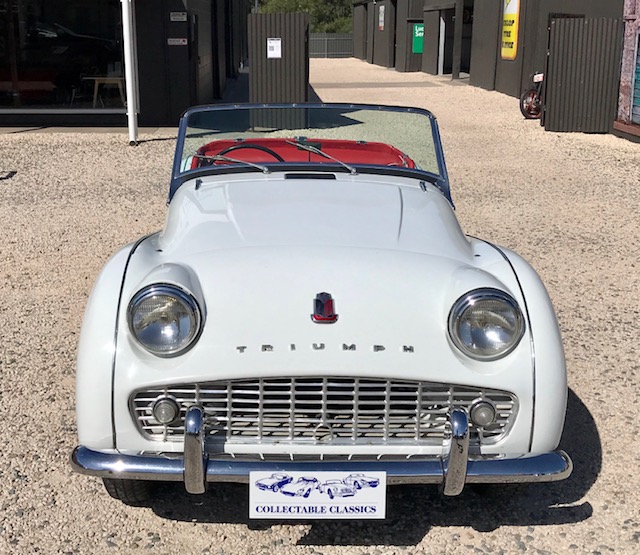
Production reached nearly 17,000 for this model of TR3. This model can be recognized by its grill: the opening is still small, but the grill itself is no longer far recessed, but nearly flush with the front valence.

In late 1955, the TR3 “small mouth” was introduced. This difference in wiper spacing is surprisingly noticeable on the cars and even in photographs, enabling one to look at a picture of a TR2 with an unknown identity and say with some certainty that it is a sub-TS995 car!Īfter the first few thousand TR2s, the Triumph factory responded to complains from owners who scraped the door bottoms on curbs by shortening the door skins, and introduced the TR2 model which has come to be known as the “small mouth short door.” Altogether, approximately 8600 TR2s were built. As the spindle holes are punched into the front scuttle and as it seems unlikely that anyone would ever alter this spacing during a rebuild, the narrow spacing remains a reliable guide to a genuine early TR2. At TS995, the spacing was increased to 14.5 inches. The earliest cars had their windscreen wipers only 10.5 inches apart, which caused only a relatively narrow area of the windscreen to be wiped. To spot a really early TR2, check the wiper spindle spacing. The early “small mouth, long door” has a small, recessed front grille and door skins that extend down to the bottom of the rocker panel. The first was the TR2, built from 1952 to 1955.
#Triumph tr3a clutch bleeding full
They all resemble bulldogs - short-squat, full of vigor, with distinguishing cut-away doors. One model of TR2/3 can be difficult to tell from another unless you know what to look for. TS 18230 E Changed to Chromium-Plated Rocker Cover, Changed Oil Filler/Breatherīy Ken Streeter, with input from Keith Martin and Bill Piggott TS 15706 Changed to Combined Tail Pipe/Silencer TS 15497 Changed to Flexible Fuel Pipe, Petrol Tap TS 13052 E Change Manifold Inlet, Cylinder Head Studs TS 13046 Changed from Lockhead to Girling Braking System, Changed Master Cylinder,įront Disc Brakes, Rear Brakes, Rear Axle, Differential, Suspension TS 12650 E Change to “Flow through” Filter Head TS 12606 E Changed to High Port Cylinder Head Assembly TS 12567 Changed Windscreen Wiper Motor Type and Location TS 11716 Change to Headpipe Clamp/Bracket TS 11384 Added Second Silencer to Tailpipe TS 9350 E Change Manifold Inlet, Head Gasket TS8997E: Change Manifold Inlet Added Cam Bearings TS 8637 1 3/4″ Stud Mounted Type H6 Carbs, Grille Flush w/Front Apron TR engines also powered versions of the Morgan sports car. Also, several other cars shared basic TR2-3 running gear, such as the Swallow Doretti, Peerless, Warwick, and the (Vignale) Italia. Total TR2-3B production was something under 80,000 cars.

A small number (3,331?) of TR3Bs were built for the North American market in 1962, largely to TR3A specification, although most of these had the larger 2138cc engine and all had the all-synchro TR4 transmission. Production of the TR3 largely ended by 1961, replaced by the mechanically similar (but with much more modern styling and comfort features) TR4. Various continual developments, changes and improvements to both body and mechanical specifications led to the TR3 model for 1956 and the TR3A version around 1958. The first “off-tools” TR2s were produced in summer 1953. The rear of the body was redone to provide a trunk and an enclosed space for the spare.Ī prototype TR2 was run on a closed stretch Jabbeke highway by Ken Richardson in spring 1953, achieving close to 125mph in “speed” trim and around 105mph in “street” trim. The Vanguard engine (2088cc) was further developed into a reliable 90hp, under 2-liter (1991cc) engine. The car eventually gained its own purpose-built chassis frame, which incorporated front suspension originally developed for the Mayflower.

Ken Richardson was soon hired by Standard-Triumph to oversee development of the car into what became the TR2. Built on a prewar Standard chassis and sporting a dual-carb version of the Standard Vanguard engine, this show car looked much like the TR2s and TR3s that later followed, although rear body styling was quite different, with a more rounded, traditional look featuring exposed spare tire. In 1952 the Type 20TS (often referred to as the TR1) is introduced at Earl’s Court Motor Show.


 0 kommentar(er)
0 kommentar(er)
